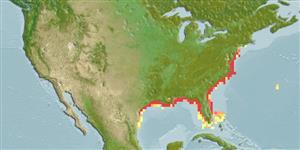Teleostei (teleosts) >
Gobiiformes (Gobies) >
Gobiidae (Gobies) > Gobiinae
Etymology: Gobiosoma: Latin, gobius = gudgeon + Greek,soma = body (Ref. 45335); bosc: Latin gobius or gobio=goby and Greek soma=body; bosc, named after Louis Augustin Guillaume Bosc (1759-1828) (French naturalist who visited America from 1796-1798) (Ref. 79012).
More on author: Lacepède.
Environment: milieu / climate zone / depth range / distribution range
Ecology
Marine; brackish; demersal. Tropical; 11°C - 33°C (Ref. 97140); 41°N - 24°N
Western Atlantic: Massachusetts to Florida, (not Florida Keys), Everglade City, Florida along Gulf of Mexico coast to Veracruz, Mexico.
Size / Weight / Age
Maturity: Lm ? range ? - ? cm
Max length : 6.0 cm TL male/unsexed; (Ref. 7251); common length : 4.1 cm TL male/unsexed; (Ref. 12193)
Inhabit estuaries and weedy, protected coastal waters (Ref. 7251) and rivers, with salinity ranging from 0.0 to 33.0 ppt (Ref. 97140). Young are found in the same places as adults (Ref. 40810). Adults feed mainly on annelids and small crustaceans; also attracted to injured or dead oysters (Ref. 79012).
Life cycle and mating behavior
Maturity | Reproduction | Spawning | Eggs | Fecundity | Larvae
Robins, C.R. and G.C. Ray, 1986. A field guide to Atlantic coast fishes of North America. Houghton Mifflin Company, Boston, U.S.A. 354 p. (Ref. 7251)
IUCN Red List Status (Ref. 130435)
Threat to humans
Harmless
Human uses
More information
Age/SizeGrowthLength-weightLength-lengthLength-frequenciesMorphometricsMorphologyLarvaeLarval dynamicsRecruitmentAbundanceBRUVS
Tools
Special reports
Download XML
Internet sources
Estimates based on models
Preferred temperature (Ref.
123201): 15.4 - 26.7, mean 24 °C (based on 194 cells).
Phylogenetic diversity index (Ref.
82804): PD
50 = 0.5000 [Uniqueness, from 0.5 = low to 2.0 = high].
Bayesian length-weight: a=0.00708 (0.00333 - 0.01504), b=3.09 (2.92 - 3.26), in cm total length, based on LWR estimates for this (Sub)family-body shape (Ref.
93245).
Trophic level (Ref.
69278): 3.2 ±0.3 se; based on size and trophs of closest relatives
Resilience (Ref.
120179): High, minimum population doubling time less than 15 months (Preliminary K or Fecundity.).
Fishing Vulnerability (Ref.
59153): Low vulnerability (10 of 100).
